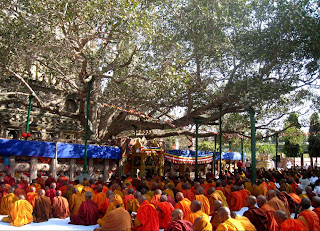Mahabodhi Temple Bodhgaya | World Famous Buddhist Pilgrimage Center
 |
| Gautam Buddha |
 |
| Mahabodhi Temple Bodhgaya |
General Information :
Temperature (Max./Min.) Deg C: Summer 47/28 Winter-28/4Rainfall:186 cms (Mid-June to Mid-September)
Altitude:113 Meters
Best Season: October to March.
What to See :
 |
| Mahabodhi Tree |
Inside the temple, in the main sanctum, there is a colossal image of the Buddha in sitting posture touching the earth by his right hand. In this posture the Buddha accomplished the supreme enlightenment. The statue is of black stone but it has been guilder by the devotees. The entire courtyard of the temple is studded with large number of votive stupas. These stupas are of all sizes built during the past 2500 years ago. Most of them are extremely elegant in structural beauty. The ancient railings, which surround the temple, are of the first century BC and are among the very interesting monuments of the century.
Animesh Lochan Chaitya: It is believed that the Buddha spent one week here looking towards the great Bodhi tree out of gratitude, without twinkling his eyes.
Bodhi Tree: The present Bodhi Tree is probably the fifth succession of the original tree under which the Buddha had attained enlightenment. Vajrasana, the seat of stability, is a stone platform on which the Buddha is supposed to have sat in meditation gazing east, under the Bodhi tree.
Chankramana: This marks the sacred spot of the Buddha's meditative perambulations during the third week after pious enlightenment. It is believed that wherever the Buddha put his feet lotus sprang up.
Ratnagarh: The Buddha spent one week here, where it is believed that five colors came out of his body.
Other Treasures of Bodhgaya: 80 ft Statue of the Buddha, Lotus Tank, Buddha Kund, Rajayatana, Brahm Yoni, Chinese Temple & Monastery, Burmese Temple, Buddhist Monastery of Bhutan, International Buddhist House & Japanese Temple, Thai Temple & Monastery, Tibetan Monastery, Archaeological Museum. Sujata village (2 kms), Dungeshwari Hill (Prag bodhi) (22 kms by road), Maitraya Project (3 kms).
Temple Timings:
Mahabodhi Temple: 5 AM to 9 PM
Other Monastries: 5 AM to 12 Noon and 2 PM to 6 PM
How to Reach:
Air: The nearest airport is at Gaya 7 Kms and Patna 135 kms. Indian Airlines and Sahara Airlines connect Patna to Calcutta, Bombay, Delhi, Ranchi, Lucknow and various other cities.
Rail: The nearest railway station is Gaya (17km).
Road: Bodhgaya is well connected by road to Gaya (17km), Nalanda (101 km), Rajgir (78 km), Patna (135km), Varanasi (252 km), Calcutta (495km)
Local Transport: Taxis, Tongas, Auto Rickshaws, Cycle Rickshaws are available.
Bus : Regular direct bus services are available from Gaya, Patna, Nalanda, Rajgir, Varanasi. Bihar State Tourism Development Corporation run buses from Patna- Bodhgaya route twice a day.
Conducted Tour : Chartered buses or taxis are arranged from Ranchi and Patna by Bihar State Tourism Development Corporation.
Where to Stay:
Bihar State Tourism Development Corporation runs three hotels - Siddhartha Vihar, Buddha Vihar and Sujata Vihar and has a Tourist Information Centre in its sprawling tourist complex campus. There is Hotel Bodhgaya Ashok run by Indian Tourism development Corporation and there are several other private hotels in the town.
Tourist Bungalows:
Siddharth Vihar, Bodhgaya, Gaya-824231
Phone: 0631-2200445, 2200127.
Rooms available: AC Rooms, Non-AC Rooms
Sujata Vihar, Bodhgaya, Gaya-824231
Phone: 0631-2200445, 2200127.
Rooms available: Dormitory Beds available only
Buddha Vihar, Bodhgaya, Gaya-824231.
Phone: 0631-2200445, 2200127.
Facility Available: Restaurant, CTV, Conference Hall, Coach/Car Parking.
Rooms available: Dormitory Beds and Conference Hall is available.
Excursions:
Sun Temple (32 km): It is a famous temple of the Sun God at Deo and has a beautiful architecture similar to the Konark Temple in Orissa. This place is famous for the 'Chhat' festival which is held in the month of October-November.
Pretshila Hill (12 km, Gaya): This hill adds to the beauty of Gaya. It is about 10 kms from the Ramshila hill. Just below the hill is the Brahma Kund. After taking bath in this pond people go for the 'Pind Dan' which involves performance of religious rites and offering donations and charity for the peace of souls of one's parents and ancestors. On top of the hill the Queen of Indore, Ahilya Bai, built a temple in 1787popularly known as Ahilya Bai Temple. This temple has always been an attraction for the tourists due to its unique architecture and magnificent sculptures.
Vishnupad Temple (12km, at Gaya): In 1787 Queen Ahilya Bai built the Vishnu temple on the banks of river Falgu. The temple has some great architecture and design which attracts devotees and tourists alike. A 30-meter high octagonal tower overshadows this temple.
Barabar Caves (41 km): It is an important archaeological site. The caves carved out from solid rocks bear details of the life of the Buddha. The interior of these caves is chiseled to a wonderful polish. The carvings in the caves reflect the skill with which these caves were carved out. These caves were built in the 3rd century and are fine examples of the skill which the Indian mansion had attained at that time. These caves of Mauryan period are rightly considered to be the origin of Indian cave architecture. It was here in these caves where the Buddha had meditated for some time and concluded that the ultimate knowledge can not be attained through mortification of the flesh.
Other Excursions: Dungeshwari (12 km), Muchalinda Lake (3 km), Gaya (12 km), Rajgir (80 km), Nalanda (96 km), Pawapuri (114 km).
No comments:
Post a Comment